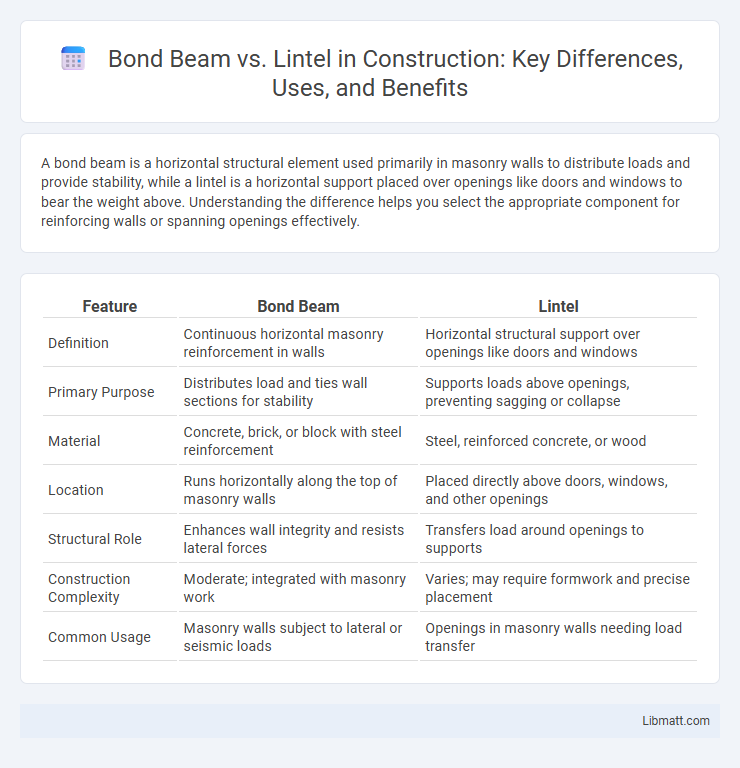A bond beam is a horizontal structural element used primarily in masonry walls to distribute loads and provide stability, while a lintel is a horizontal support placed over openings like doors and windows to bear the weight above. Understanding the difference helps you select the appropriate component for reinforcing walls or spanning openings effectively.
Table of Comparison
| Feature | Bond Beam | Lintel |
|---|---|---|
| Definition | Continuous horizontal masonry reinforcement in walls | Horizontal structural support over openings like doors and windows |
| Primary Purpose | Distributes load and ties wall sections for stability | Supports loads above openings, preventing sagging or collapse |
| Material | Concrete, brick, or block with steel reinforcement | Steel, reinforced concrete, or wood |
| Location | Runs horizontally along the top of masonry walls | Placed directly above doors, windows, and other openings |
| Structural Role | Enhances wall integrity and resists lateral forces | Transfers load around openings to supports |
| Construction Complexity | Moderate; integrated with masonry work | Varies; may require formwork and precise placement |
| Common Usage | Masonry walls subject to lateral or seismic loads | Openings in masonry walls needing load transfer |
Introduction to Bond Beam and Lintel
Bond beams are horizontal structural elements typically constructed within masonry walls to provide lateral support and distribute loads evenly, enhancing wall stability and resistance to shear forces. Lintels are horizontal beams spanning openings such as doors and windows, designed to carry the load from the structure above and transfer it to the adjacent masonry, preventing collapse or deformation. Both components are integral in masonry construction, with bond beams reinforcing wall integrity and lintels ensuring proper load transfer over openings.
Definition and Purpose of Bond Beam
A bond beam is a horizontal structural element designed to reinforce masonry walls and distribute loads evenly, preventing cracking and movement. Unlike a lintel, which spans openings such as doors and windows to support weight above, a bond beam ties the entire wall together for increased stability. Your masonry construction benefits from bond beams through enhanced durability and resistance to lateral forces.
Definition and Purpose of Lintel
A lintel is a horizontal structural element placed above openings like doors and windows to support the weight of the wall above. Its primary purpose is to transfer loads from the superstructure to the adjacent masonry or framework, ensuring stability and preventing cracks. Unlike bond beams, which reinforce wall continuity and resist lateral forces, lintels specifically provide immediate support over openings.
Key Structural Differences
Bond beams are horizontal structural elements that distribute load across multiple masonry units, reinforcing walls and improving resistance to lateral forces. Lintels, typically made of steel, reinforced concrete, or wood, span openings like windows and doors, supporting the weight above these voids. Your choice between a bond beam and a lintel depends on the specific structural requirements and load distribution needs of your construction project.
Materials Used in Bond Beams vs Lintels
Bond beams are typically constructed using reinforced concrete or grout-filled masonry units with steel rebar to enhance structural integrity and distribute loads evenly across walls. Lintels, on the other hand, may be made from a wider range of materials including reinforced concrete, steel, wood, or stone, chosen for their ability to span openings like doors and windows while supporting vertical loads above. The selection of materials in bond beams prioritizes uniform reinforcement within masonry walls, whereas lintels are selected based on span length, load requirements, and architectural considerations.
Typical Applications in Construction
Bond beams are commonly used in masonry walls to provide horizontal reinforcement and structural stability, especially in retaining walls, foundation walls, and fence walls. Lintels serve as horizontal support over openings like doors and windows, distributing loads from above to adjacent structural elements in both masonry and concrete construction. Both elements ensure load transfer and structural integrity but are applied based on the need for horizontal reinforcement (bond beam) or opening support (lintel).
Installation Process Comparison
The installation process of a bond beam involves laying horizontal reinforced concrete within masonry walls to provide structural integrity and distribute loads evenly, typically requiring formwork and steel reinforcement setup before pouring concrete. In contrast, a lintel installation requires placing a pre-cast or cast-in-place horizontal support above openings like doors or windows to carry the load from above, often involving temporary shoring and precise positioning for stability. Your choice depends on structural needs and construction sequence, with bond beams integrating into masonry courses and lintels serving as localized load-bearing elements.
Advantages of Bond Beams
Bond beams provide enhanced structural integrity by evenly distributing lateral loads across masonry walls, reducing the risk of cracking and improving seismic performance. They facilitate the integration of reinforcement, such as horizontal steel bars, resulting in stronger, more durable walls capable of supporting heavier loads. Bond beams also improve the building's overall resistance to wind and soil pressure, making them ideal for retaining walls and taller structures.
Benefits of Using Lintels
Lintels provide critical support by spanning openings such as doors and windows, effectively carrying the load from above and distributing it to adjacent supports. They enable cleaner architectural lines and facilitate precise placement of windows and doors, often allowing for larger openings than bond beams. Lintels, typically made from reinforced concrete, steel, or stone, enhance structural integrity and durability, especially in seismic zones or heavily loaded walls.
Choosing Between Bond Beam and Lintel
Choosing between a bond beam and a lintel depends on structural requirements and load distribution in masonry construction. Bond beams provide horizontal reinforcement and help resist lateral loads, ideal for walls requiring continuous support, while lintels span openings like doors or windows, bearing direct vertical loads above these gaps. Selecting the appropriate element hinges on factors such as wall design, load type, and architectural specifications to ensure stability and durability.
Bond beam vs Lintel Infographic

 libmatt.com
libmatt.com